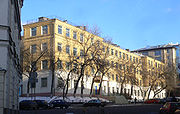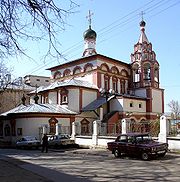
Khitrovka
Encyclopedia

Moscow
Moscow is the capital, the most populous city, and the most populous federal subject of Russia. The city is a major political, economic, cultural, scientific, religious, financial, educational, and transportation centre of Russia and the continent...
from 1820 to 1930. This square was located in place of today’s house №11a in Podkolokolny sidestreet. In the second half of the 19th century Khitrovka became a bawdy place of Moscow, a den for thousands of unemployed and criminals. It is described by V.A. Gilyarovsky
Vladimir Gilyarovsky
Vladimir Alekseyevich Gilyarovsky , was a Russian writer and newspaper journalist, best known for his reminiscences of life in pre-Revolutionary Moscow , which he first published in a book form in 1926.-Biography:...
, C.S. Stanislavsky and other authors.
History

Fire of Moscow (1812)
The 1812 Fire of Moscow broke out on September 14, 1812 in Moscow on the day when Russian troops and most residents abandoned the city and Napoleon's vanguard troops entered the city following the Battle of Borodino...
. In 1823 the waste land was bought by major-general N.Z. Khitrovo who was granted with a permission to erect a meat and greens market there. Khitrovo died in 1826 before he had time to complete this work. The idle market was used each year only for a short period in wintertime, from Christmas to «mjasoyed» (two weeks before Maslenitsa), when peasants from around Moscow came to sell frozen meat, poultry and venison.
In the 1860s Khitrovka became a job market for unskilled labour, drawing unemployed peasants who were seeking their fortune in the big city. Many of them couldn’t find work and settled here forever. The square was a shelter for escaped convicts, broken citizens and other hard up people. Four doss-houses faced the square.
These places were visited repeatedly in late 19th – early 20th century by L.N. Tolstoy
Leo Tolstoy
Lev Nikolayevich Tolstoy was a Russian writer who primarily wrote novels and short stories. Later in life, he also wrote plays and essays. His two most famous works, the novels War and Peace and Anna Karenina, are acknowledged as two of the greatest novels of all time and a pinnacle of realist...
, T.L. Schepkina-Kupernik, V.A. Gilyarovsky, C.S. Stanislavsky, V.I. Nemirovich-Danchenko
Vladimir Nemirovich-Danchenko
Vladimir Ivanovich Nemirovich-Danchenko was a Georgian-born Russian theatre director, writer, pedagogue, playwright, producer and theatre organizer, who founded the Moscow Art Theatre with his colleague, Konstantin Stanislavsky, in 1898.-Biography:Vladimir Ivanovich Nemirovich-Danchenko was born...
and the artist V.A. Simov who painted decorations for the play «the Lower Depths» by M. Gorky
Maxim Gorky
Alexei Maximovich Peshkov , primarily known as Maxim Gorky , was a Russian and Soviet author, a founder of the Socialist Realism literary method and a political activist.-Early years:...
. A.K. Savrasov
Alexei Savrasov
Alexei Kondratyevich Savrasov was a Russian landscape painter and creator of the lyrical landscape style.-Biography:Savrasov was born into the family of a merchant...
finished his life in poverty here. The grand duchess Elizaveta Fedorovna, the foundress of Marfo-Mariinsky Convent
Marfo-Mariinsky Convent
Marfo-Mariinsky Convent, or Martha and Mary Convent of Mercy in the Possession of Grand Duchess Elizabeth Feodorovna is a female cloister in Moscow....
, established the school in the convent for orphans and children picked up by her at the Khitrov marketplace.
All the dens were liquidated in twenties of the 20th century; before world war II a school was built on the square.
Current situation
In 2008 «DON-stroy», a building company, has designed a project of building-up of the former Khitrov square. According to this plan, an eight-storied office centre shall be erected in place of the electromechanics college located in 11a Podkolokolny sidestreet. These plans of a modern office building of glass and concrete in the very heart of the famous Khitrovka became a reason for arising of a great protest from the local grass root organisations, as well as other citizens of Moscow. Several collective appeals to the authorities have taken place; collection of signatures is now being carried out..In January 2010 the building of the former college was torn down illegally http://community.livejournal.com/ivanovska_gorka/265872.html as a first step towards the construction of a modern business centre in the midst of a theoretically protected historical area.
Sights

- Khitrovo’s house (18th century) (16A Podkolokolny sidestreet)
- City manor of Lopukhiny-Kirjakovy (mid. 18th – early 19th century) A.N. ScriabinAlexander ScriabinAlexander Nikolayevich Scriabin was a Russian composer and pianist who initially developed a lyrical and idiosyncratic tonal language inspired by the music of Frédéric Chopin. Quite independent of the innovations of Arnold Schoenberg, Scriabin developed an increasingly atonal musical system,...
, the famous Russian composer and pianist, was born here on 25 December in 1871 (3/1, building 2 Khitrovsky sidestreet) - Stolnik Buturlin’s mansion (17th century) (11/11/1, 2 building Podkopaevsky sidestreet)
- Former Osterman’s manor (18th century) – former Miasnitsky police station (19th century) (2 Chitrovsky sidestreet)
All the three churches surrounding Khitrovka have been preserved:
- Church of St. Peter and St. Paul near Yauza gate (1700, bell tower 1771)
- Church of St. Nicholas the WonderworkerSaint NicholasSaint Nicholas , also called Nikolaos of Myra, was a historic 4th-century saint and Greek Bishop of Myra . Because of the many miracles attributed to his intercession, he is also known as Nikolaos the Wonderworker...
of Podkopai (17th century, bell tower 1750) - Church of the Three Holy HierarchsThree Holy HierarchsThe Three Holy Hierarchs of Eastern Christianity refers to Basil the Great , Gregory the Theologian and John Chrysostom. They were highly influential bishops of the early church who played pivotal roles in shaping Christian theology...
in Kulishki (1670–1674)

